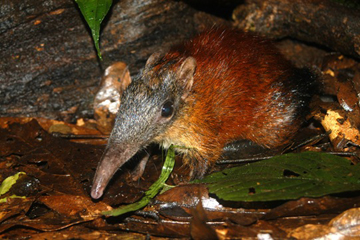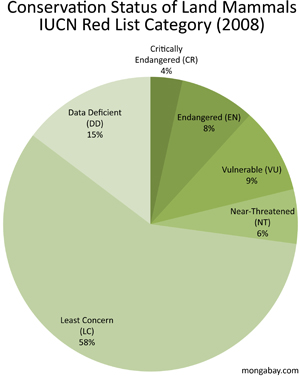|
|
The discovery of 408 species of mammals — the planet’s best-known group of animals — since 1993 demonstrates our poor understanding of global biodiversity, argue scientists writing in Proceedings of the National Academy of Sciences.
Analyzing discoveries of mammal species since 1993, Paul Ehrlich of Stanford University and Gerardo Ceballos of the Mexico’s National University found that “a substantial number persist only in areas undergoing rapid habitat destruction” implying “even greater threats to ecosystem services and human well-being than previously assumed” since mammals are generally the best-studied and most “charismatic” of animals.
 The recently discovered Grey-faced sengi. Photos by Francesco Rovero. |
“What this paper really talks about is how little we actually know about our natural capital and how little we know about the services that flow from it,” said Paul Ehrlich, adding that the diminishment of biodiversity can have very significant impacts on mankind.
“I think what most people miss is that the human economy is a wholly owned subsidiary of the economy of nature, which supplies us from our natural capital a steady flow of income that we can’t do without. And that income is in the form of what are called ‘ecosystem services’-keeping carbon dioxide out of the atmosphere, supplying fresh water, preventing floods, protecting our crops from pests and pollinating many of them, recycling the nutrients that are essential to agriculture and forestry, and on and on,” he said.
“Our analysis indicates how much more varied biodiversity is than we thought and how much bigger our conservation problems are if we’re going to maintain the life-support services that we need from biodiversity.”
He cited disease control as an example.
 Click image to enlarge |
“There’s an important set of diseases called hantaviruses that infects human beings and quite frequently kills them. And it turns out that if you reduce the diversity of the different species of rodents, say, in a forest, the rodents that carry hantaviruses can become more common. And the results for human beings are more death and disease,” Ehrlich explained. “So by reducing the diversity of mouse-like creatures in a forest, you can make that forest more dangerous for people.”
New discoveries
Ehrlich and Ceballos found that of the 408 “new” species, 221 have restricted distribution, while 23 are already likely at risk of extinction. 40 percent of the species are large and distinctive, the balance are “cryptic”. Many of the discoveries have occurred in areas that are not considered “biodiversity hotspots”.
Worldwide half of mammal species are in decline, according to last year’s IUCN new assessment of the planet’s 5,487 mammals. 21 percent are at risk of extinction.
Gerardo Ceballos and Paul R. Ehrlich. Discoveries of new mammal species and their implications for conservation and ecosystem services. PNAS for the week of Feb 9, 2009